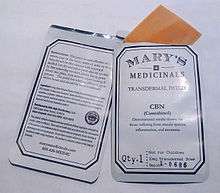Cannabinol
 | |
 | |
| Clinical data | |
|---|---|
| ATC code | none |
| Legal status | |
| Legal status |
|
| Identifiers | |
| |
| CAS Number |
521-35-7 |
| PubChem (CID) | 2543 |
| IUPHAR/BPS | 740 |
| ChemSpider |
2447 |
| UNII |
7UYP6MC9GH |
| KEGG |
C07580 |
| ChEMBL |
CHEMBL74415 |
| ECHA InfoCard | 100.216.772 |
| Chemical and physical data | |
| Formula | C21H26O2 |
| Molar mass | 310.4319 g/mol |
| 3D model (Jmol) | Interactive image |
| Melting point | 77 °C (171 °F) [1] |
| Solubility in water |
insoluble in water[2] soluble in methanol[3] and ethanol[4] mg/mL (20 °C) |
| |
| |
| | |
Cannabinol (CBN) is a weak psychoactive cannabinoid found only in trace amounts in Cannabis sativa and Cannabis indica.[5] Pharmacologically relevant quantities are formed as a metabolite of tetrahydrocannabinol (THC) .[6] CBN acts as a partial agonist at the CB1 receptors, but has a higher affinity to CB2 receptors, however; with lower affinities in comparison to THC.[7][8] Degraded or oxidized cannabis products, such as low-quality baled cannabis and traditionally produced hashish, are high in CBN, but modern production processes minimize the formation of CBN.[9] Cannabinol has been shown to have analgesic properties.[10]
Unlike other cannabinoids, CBN does not stem from cannabigerol (CBG) but rather is the degraded product of THC. If cannabis is exposed to air or ultraviolet light (for example, in sunlight) for a prolonged period of time, tetrahydrocannabinolic acid (THCA) will convert to cannabinolic acid (CBNA). CBN is then formed by decarboxylation of CBNA.[11]
Chemistry
In contrast to THC, CBN has no double bond isomers nor stereoisomers. Both THC and CBN activate the CB1 and CB2 receptors.[12]
Legal status
CBN is not scheduled by the United Nations' Convention on Psychotropic Substances.
United States
CBN is not scheduled at the federal level in the United States,[13] but it could legally be considered an analog of THC and sales or possession could be prosecuted under the Federal Analogue Act.

References
- ↑ Cannabinol in the ChemIDplus database.
- ↑ David R. Lide (2012). CRC Handbook of Chemistry and Physics. CRC Press. pp. 3–90. ISBN 1-43988049-2.
- ↑ Sigma-Aldrich Co., Cannabinol solution, 1.0 mg/mL in methanol, analytical standard, for drug analysis.
- ↑ Biotrend: Cannabinol (PDF: 21 kB)
- ↑ Karniol IG, Shirakawa I, Takahashi RN, Knobel E, Musty RE (1975). "Effects of delta9-tetrahydrocannabinol and cannabinol in man". Pharmacology. 13 (6): 502–12. doi:10.1159/000136944. PMID 1221432.
- ↑ McCallum ND, Yagen B, Levy S, Mechoulam R (May 1975). "Cannabinol: a rapidly formed metabolite of delta-1- and delta-6-tetrahydrocannabinol". Experientia. 31 (5): 520–1. doi:10.1007/bf01932433. PMID 1140243.
- ↑ Mahadevan A, Siegel C, Martin BR, Abood ME, Beletskaya I, Razdan RK (October 2000). "Novel cannabinol probes for CB1 and CB2 cannabinoid receptors". Journal of Medicinal Chemistry. 43 (20): 3778–85. doi:10.1021/jm0001572. PMID 11020293.
- ↑ Petitet F, Jeantaud B, Reibaud M, Imperato A, Dubroeucq MC (1998). "Complex pharmacology of natural cannabinoids: evidence for partial agonist activity of delta9-tetrahydrocannabinol and antagonist activity of cannabidiol on rat brain cannabinoid receptors". Life Sciences. 63 (1): PL1–6. doi:10.1016/S0024-3205(98)00238-0. PMID 9667767.
- ↑ https://www.whaxy.com/learn/what-is-cbn-cannabinol
- ↑ "Comparative analgesic activity of various naturally occurring cannabinoids in mice and rats". Psychopharmacologia. 40: 285–295. doi:10.1007/BF00421466.
- ↑ Medical Jane, Cannabinol CBN
- ↑ CBN: The Lazy Stoner's Cannabinoid
- ↑ §1308.11 Schedule I.
External links
- Erowid Compounds found in Cannabis sativa